 Pin
Pin It is perhaps fitting that one nation, Canada, should have recognized the elegance, industry and charm of the beaver by selecting it as its national animal.
Regrettably, this acknowledgement is quite recent since historical records clearly state that beavers were once more numerous and widespread than they are today.
The European Beaver (Castor fiber) was common in Britain until the Middle Ages when determined hunting largely eliminated the population, a story that was repeated in the rest of Europe.
The North American Beaver (Castor canadenis) was initially hunted by the Red Indians, who wisely selected mature individuals and so minimized the effect of trapping on the beaver population.
Unfortunately the white hunters were not as discriminating. At the height of the fur trading the Hudson’s Bay Company, for instance. marketed 120,000 pelts per year with the predictable result that throughout much of the United States, as in Great Britain and most parts of Europe, the beaver was exterminated.
Today the beaver lives in Scandinavia, Russia, France, Canada and the adjacent states of the U.S.A. In all areas it is a protected animal.
Beavers are large rodents, males weighing up to 27 kilograms (55lbs and measuring up to a little over a metre (3½ feet) in length.
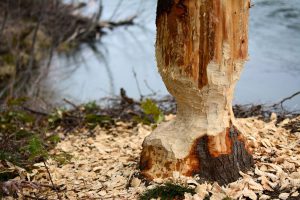 Pin
Pin  Pin
Pin They live in lodges or burrows in streams and ponds and the young beavers remain for two years with their parents. Since a litter of two to four young are born every spring, then at any time a family consists of the parents, the young of the previous year and the current infants. When a two year old beaver leaves home it finds a mate and the pair, which remain together throughout their lives, may settle in the parental pond or one nearby.
Beavers do not depend on natural ponds but can create their own by building dams and it is this ability for which they are famous.
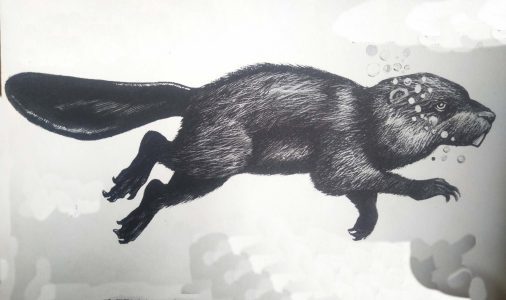 Pin
Pin The large, flat scaly tail is often as much as one third of the beaver’s total length. It is used in an up-and-down motion in swimming and for slapping the surface of the water as a warning signal.
Nose and ears can be closed with the aid of special flaps of skin when swimming.
Only the hind legs have webbed feet.
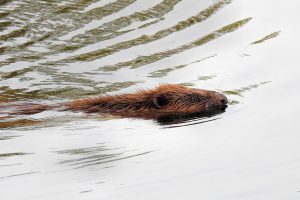 Pin
Pin Beavers are expert swimmers and they spend much of their time cruising just below the surface when often all that is visible are their nostrils and the V-shaped wake. Most of the power is provided by their webbed hind feet but the tail also helps at low speeds.
 Pin
Pin A beaver’s incisors, or front teeth, are self-sharpening chisels. Daily use causes the softer dentine, or main tissue of the teeth, to wear away more quickly than the harder enamel along the front edge.
Dam builders
Sitting up and balancing on their tails, they use their incisor teeth to gnaw through the bases of aspen saplings and young trees and can then manipulate the trunks and branches into position at a dam site using their hands.
If the tree is a long way from the site the beaver may float the log into position or they may dig flotation ditches to ease the movement of saplings.
The trees and branches are stuck together with mud and the dam its then kept in a state of good repair. Once a pond has been filled with water the beaver may dig a hole in the bank using the claws of its forelimbs or it may construct a lodge. In either case the entrances to this home are under water with a tunnel running upwards to a living area which is located above the water level.
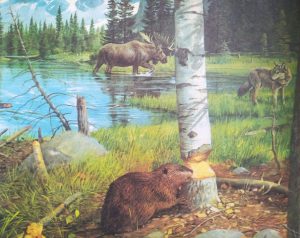 Pin
Pin 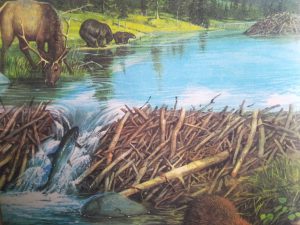 Pin
Pin The lodges are made from successive horizontal layers of branches stuck together with mud, and finally covered by a roof of branches about three feet above the surface of the water. Inside there is the living platform and in the roof there is a chimney which provides for circulation of air.
In any one pond there may be several families but they all live independently, cutting their own trees and mending their own lodges. Even the dams are maintained by all the beavers separately and they do not co-operate together at all.
However, in a large pond with several dams a certain minimum number of beaver families is necessary to keep the dam in good condition and so maintain the pond water level. If this water level drops below the entrance to the lodges predators can enter and the beavers lose their security.
Expert swimmers
Beavers are good swimmers, well adapted to life in the bitterly cold waters of the northern latitudes. Their thick, furry, waterproof coats keep them warm even in the winters when the pond surface is covered with ice. Their. webbed hind feet push them through the water power-fully and their ears and noses can be closed to keep the water out.
The tail of the beaver plays a special role; it is large and scaly, broad and flattened and functions in several ways.
In summer, when the beaver is in danger of overheating because of its thick fur, the tail provides an area from which heat can be lost. A beaver also uses its tail as an oar in swimming and if danger threatens a swimming beaver, it can warn the colony by slapping the tail against the surface of the water as it dives to safety.
Beavers feed on berries, leaves, roots and the bark of trees. Having felled a tree, a beaver may strip the bark from its surface with its incisors. The fronts of these teeth are covered by a thick layer of orange enamel and this wears away slowly while the backs of the teeth wear away more rapidly, thus ensuring a constant sharp cutting edge. This is, in fact, a feature common to all rodents.
Food store
In the autumn the beavers store quantities of twigs and branches beneath the surface of the water near the lodge. They do not hibernate in the true sense of the word but remain in the lodge during the winter, using these stores of food to sustain themselves.
Beavers have a considerable effect on their environment. The damming of the streams increases the amount of water available, by slowing the flow of mountain snow meltwater and provides the perfect habitat for a variety of ducks, geese and other water birds which feed on the increased number of plants and invertebrates.
Fish flourish in beaver rivers including the valuable trout and salmon. Predators, such as wolves, coyotes, bears, and cougars also increase in number. These animals prey not only upon the beaver but also on the moose and elk which feed especially in the areas where the beaver ponds have silted up to form valuable meadows.
It is this effect that the beaver has upon its environment which makes it so useful. Consequently, its conservation and reintroduction to areas where it is extinct, become all the more important.
More about Beavers
Beavers are known for their remarkable ability to build dams across streams and rivers. These semi-aquatic rodents construct these structures using a combination of their instinctive behavior, physical adaptations, and environmental factors. The primary reason why beavers build dams is to create a suitable habitat for themselves and their families.
One of the main benefits of constructing dams is that it allows beavers to control water levels in their surroundings. By creating large ponds or wetlands, they can effectively maintain a constant water level by blocking the natural flow of water. This is particularly important during dry seasons when water sources might become scarce. The dams enable beavers to have a consistent supply of water for drinking, feeding, and survival.
The dams also act as a defense mechanism by protecting beavers against predators. By raising the water levels, beavers create a physical barrier that prevents predators like coyotes, wolves, and bears from easily accessing their lodges. The deeper water makes it much more challenging for predators to approach quietly, giving the beavers a significant advantage and increasing their chances of survival.
Furthermore, the raised water levels also aid in the transportation of food and building materials. Beavers primarily feed on the inner bark of trees, especially as food reserves during winter months. The dams assist them by flooding the surrounding area, making it easier for them to access trees and enabling them to store logs for later consumption. Additionally, beavers use these logs to build their lodges and repair existing structures.
The dams also have a positive effect on the local ecosystem. The creation of ponds or wetlands can provide habitats for a diverse range of plant and animal species. The increased water availability attracts various aquatic plants, insects, birds, and fish, thereby promoting biodiversity. These wetlands become a hotspot for wildlife as they offer a rich food source and shelter.
It is worth noting that beavers are incredible architects, and their dam-building behavior is deeply ingrained in their genetic makeup. They possess several physical adaptations that allow them to construct dams efficiently. Their large incisors, for example, continue growing throughout their lives, which helps them gnaw through trees to obtain building materials.
Furthermore, their dense fur and webbed hind feet provide excellent waterproofing and increase their agility in water, enabling them to transport heavy logs and mud to construct and reinforce their dams.
Overall, beavers build dams for various reasons and achieve multiple benefits by doing so. Their instinctive behavior, physical adaptations, and the resulting creation of wetland habitats contribute to their long-term survival and the overall ecological balance of their specific environments.
Beavers' dam-building activities have significant impacts on surrounding ecosystems and provide various ecological benefits. Here's a breakdown:
Hydrological Impact
Copied
Hydrological Impact
Beavers build dams across streams and rivers, leading to the creation of ponds. These ponds modify the local hydrology by increasing water storage and reducing downstream flow. This altered hydrology offers several benefits:
a. Water Filtration: The ponds created by beavers act as natural filters, trapping sediments and pollutants. Consequently, they improve water quality downstream.
b. Flood Mitigation: The dams help regulate water flow during heavy rainfall events, reducing downstream flooding by storing excess water.
c. Drought Resistance: In dry periods, beaver ponds act as reservoirs and maintain higher water levels, ensuring water availability for aquatic organisms, especially during droughts.
Beavers build dams across streams and rivers, leading to the creation of ponds. These ponds modify the local hydrology by increasing water storage and reducing downstream flow. This altered hydrology offers several benefits:
a. Water Filtration: The ponds created by beavers act as natural filters, trapping sediments and pollutants. Consequently, they improve water quality downstream.
b. Flood Mitigation: The dams help regulate water flow during heavy rainfall events, reducing downstream flooding by storing excess water.
c. Drought Resistance: In dry periods, beaver ponds act as reservoirs and maintain higher water levels, ensuring water availability for aquatic organisms, especially during droughts.
Beavers build dams across streams and rivers, leading to the creation of ponds. These ponds modify the local hydrology by increasing water storage and reducing downstream flow. This altered hydrology offers several benefits:
a. Water Filtration: The ponds created by beavers act as natural filters, trapping sediments and pollutants. Consequently, they improve water quality downstream.
b. Flood Mitigation: The dams help regulate water flow during heavy rainfall events, reducing downstream flooding by storing excess water.
c. Drought Resistance: In dry periods, beaver ponds act as reservoirs and maintain higher water levels, ensuring water availability for aquatic organisms, especially during droughts.
Habitat Creation and Enhancement
Copied
Habitat Creation and Enhancement
Beavers are considered ecosystem engineers as their dam-building activities create and enhance habitats for various organisms:
a. Wetland Formation: The creation of beaver ponds leads to the formation or expansion of wetland ecosystems. Wetlands provide important habitat for diverse flora and fauna, including water-dependent plants, amphibians, waterfowl, and fish.
b. Biodiversity Support: The diverse habitats created by beavers attract and support a wide range of species. They provide nesting and foraging sites for birds, reptiles, and mammals, and create diverse aquatic habitats for fish and invertebrates.
c. Riparian Vegetation: The flooding caused by beaver ponds facilitates the growth of riparian vegetation. These areas have dense vegetation, including trees, shrubs, and grasses, providing food, shelter, and additional habitat diversity.
d. Nutrient Cycling: The decay of beaver ponds' organic matter contributes to nutrient cycling and fertilization of adjacent ecosystems, enhancing productivity.
Beavers are considered ecosystem engineers as their dam-building activities create and enhance habitats for various organisms:
a. Wetland Formation: The creation of beaver ponds leads to the formation or expansion of wetland ecosystems. Wetlands provide important habitat for diverse flora and fauna, including water-dependent plants, amphibians, waterfowl, and fish.
b. Biodiversity Support: The diverse habitats created by beavers attract and support a wide range of species. They provide nesting and foraging sites for birds, reptiles, and mammals, and create diverse aquatic habitats for fish and invertebrates.
c. Riparian Vegetation: The flooding caused by beaver ponds facilitates the growth of riparian vegetation. These areas have dense vegetation, including trees, shrubs, and grasses, providing food, shelter, and additional habitat diversity.
d. Nutrient Cycling: The decay of beaver ponds' organic matter contributes to nutrient cycling and fertilization of adjacent ecosystems, enhancing productivity.
Beavers are considered ecosystem engineers as their dam-building activities create and enhance habitats for various organisms:
a. Wetland Formation: The creation of beaver ponds leads to the formation or expansion of wetland ecosystems. Wetlands provide important habitat for diverse flora and fauna, including water-dependent plants, amphibians, waterfowl, and fish.
b. Biodiversity Support: The diverse habitats created by beavers attract and support a wide range of species. They provide nesting and foraging sites for birds, reptiles, and mammals, and create diverse aquatic habitats for fish and invertebrates.
c. Riparian Vegetation: The flooding caused by beaver ponds facilitates the growth of riparian vegetation. These areas have dense vegetation, including trees, shrubs, and grasses, providing food, shelter, and additional habitat diversity.
d. Nutrient Cycling: The decay of beaver ponds’ organic matter contributes to nutrient cycling and fertilization of adjacent ecosystems, enhancing productivity.
Climate Change Impact
Copied
Climate Change Impact
Beavers' dam-building activities also have implications for climate change:
a. Carbon Sequestration: The wetlands created by beaver dams contribute to carbon sequestration, helping mitigate climate change by storing carbon in vegetation and peat.
b. Water Regulation: Beaver ponds increase water retention, delaying water release into downstream ecosystems. This prolonged water availability in drier periods can help mitigate the impacts of climate change-induced droughts.
Beavers' dam-building activities also have implications for climate change:
a. Carbon Sequestration: The wetlands created by beaver dams contribute to carbon sequestration, helping mitigate climate change by storing carbon in vegetation and peat.
b. Water Regulation: Beaver ponds increase water retention, delaying water release into downstream ecosystems. This prolonged water availability in drier periods can help mitigate the impacts of climate change-induced droughts.
Beavers’ dam-building activities also have implications for climate change:
a. Carbon Sequestration: The wetlands created by beaver dams contribute to carbon sequestration, helping mitigate climate change by storing carbon in vegetation and peat.
b. Water Regulation: Beaver ponds increase water retention, delaying water release into downstream ecosystems. This prolonged water availability in drier periods can help mitigate the impacts of climate change-induced droughts.
Beavers have several specific adaptations and behaviors that allow them to effectively build dams and create complex water systems. These include:
-
01
Strong and sharp incisors
Beavers have long, sharp, and continuously growing incisors that are specifically adapted for gnawing through trees. These incisors help them fell trees and construct their dams and lodges.
-
02
Webbed hind feet
Beavers have wide, webbed hind feet that serve as efficient paddles in water. This adaptation helps them navigate through water bodies swiftly, allowing them to transport building materials and travel between different parts of their complex water systems.
-
03
Waterproof fur
Beavers possess a unique double layer of fur. The outer layer consists of coarse guard hairs that repel water, while the dense inner layer provides insulation and keeps the beaver warm underwater. This adaptation allows beavers to spend ample time submerged while constructing their dams, without losing body heat.
CopiedWaterproof furBeavers possess a unique double layer of fur. The outer layer consists of coarse guard hairs that repel water, while the dense inner layer provides insulation and keeps the beaver warm underwater. This adaptation allows beavers to spend ample time submerged while constructing their dams, without losing body heat.
-
04
Skillful swimming
Beavers are excellent swimmers and can hold their breath for up to 15 minutes underwater. They use their powerful tails, which are flattened horizontally and covered in scales, as rudders for steering while swimming.
-
05
Lodge construction
Beavers build lodges using branches, sticks, and mud. These lodges have underwater entrances, ensuring that they are safe from predators. The interior has different compartments, including a dry living space above the waterline where the beavers rest and raise their kits.
-
06
Dam building
Beavers build dams across streams and rivers using a combination of branches, logs, mud, and rocks. They use their powerful incisors to fell trees and strip off the bark, which they then use in the construction of the dam. These dams help create deep ponds, providing a safe habitat for the beavers and allowing them to store food during winter months.
CopiedDam buildingBeavers build dams across streams and rivers using a combination of branches, logs, mud, and rocks. They use their powerful incisors to fell trees and strip off the bark, which they then use in the construction of the dam. These dams help create deep ponds, providing a safe habitat for the beavers and allowing them to store food during winter months.
-
07
Water management
Beavers are meticulous engineers and carefully manage the flow of water in their dams and complex systems. By constructing their dams, they control the water levels, which in turn creates a suitable environment for building their lodges, protecting themselves from predators, and accessing food sources.
CopiedWater managementBeavers are meticulous engineers and carefully manage the flow of water in their dams and complex systems. By constructing their dams, they control the water levels, which in turn creates a suitable environment for building their lodges, protecting themselves from predators, and accessing food sources.
In summary, beavers have a range of specific adaptations, including their strong incisors, webbed hind feet, waterproof fur, skillful swimming abilities, lodge construction skills, dam building capabilities, and water management techniques. These adaptations and behaviors enable them to effectively build dams and create complex water systems that serve as their habitats.
Beavers choose the location for building their dams based on several factors:
Water Availability
Beavers prefer to build dams in locations with a sufficient water source like rivers, streams, or small bodies of water. They require a constant water supply to ensure their survival and the success of their dam.
Accessibility
Beavers look for areas where they can easily access the construction materials, such as trees and shrubs, required to build their dam. They prefer locations with a dense vegetation cover nearby to provide enough building materials.
Suitable Soil
Copied
Suitable Soil
The soil composition plays a crucial role in dam construction. Beavers prefer locations with clay or silt-rich soil, as these soils retain water effectively and provide stability to the dam structure. Loose or sandy soils may not hold water and may be unsuitable for dam building.
The soil composition plays a crucial role in dam construction. Beavers prefer locations with clay or silt-rich soil, as these soils retain water effectively and provide stability to the dam structure. Loose or sandy soils may not hold water and may be unsuitable for dam building.
The soil composition plays a crucial role in dam construction. Beavers prefer locations with clay or silt-rich soil, as these soils retain water effectively and provide stability to the dam structure. Loose or sandy soils may not hold water and may be unsuitable for dam building.
Topography
Beavers prefer locations where they can create a deeper pond or impoundment behind their dam. They look for areas with a slight slope or natural depressions, allowing them to create a larger and more stable pond.
Vegetation
Beavers typically choose locations with a variety of vegetation, especially aquatic plants, as a food source. Vegetation also plays a role in stabilizing the dams by providing additional support and preventing erosion.
Beavers are large, semi-aquatic rodents known for their impressive construction abilities and their ability to drastically transform their habitat. They are native to North America, Europe, and Asia. They belong to the genus Castor and are primarily known for their ecological importance and their characteristic dams and lodges.
Beavers are the largest rodents in North America, with adults measuring around 3 to 4 feet in length, excluding their tails, which can add an additional 9 to 10 inches. They are robust animals, weighing between 30 to 60 pounds, depending on their age, sex, and geographic location. Their fur coats are thick and waterproof, providing excellent insulation in cold water environments.
One of the most distinguishing features of beavers is their large, flat tails. These tails serve multiple purposes. They act as a rudder in the water, providing stability and control while swimming. On land, their tails help to balance their heavy bodies. Additionally, beavers use their tails to communicate with each other, slapping the water’s surface to warn others of danger.
Beavers are well-known for their exceptional engineering skills. They construct elaborate dams in rivers and streams, using branches, logs, stones, and mud. These dams serve multiple purposes such as:
1. Flood control: The dams help to control water levels in the surrounding areas, preventing flooding during heavy rains.
2. Habitat creation: The resulting ponds created by the dams provide sheltered areas for aquatic plants, insects, fish, and amphibians. These habitats also attract a variety of bird species.
3. Food storage: Beavers build their dams close to their lodges, allowing them to access stored food underwater during winter months when food is scarce.
Beavers are herbivorous animals, primarily feeding on the inner bark and cambium layer of trees such as aspen, birch, willow, and maple. These trees are often felled by the beavers to use as building material and food. Their sharp incisors and powerful jaws enable them to cut down trees with ease. They also consume aquatic plants, grasses, and shrubs.
In addition to their dams, beavers construct impressive lodges, which serve as their homes. These lodges are typically made from branches, logs, and mud. They have an entrance underwater, leading to a dry living chamber above the waterline. Beavers are known for their familial social structure, living in family groups consisting of a monogamous breeding pair and their offspring.
Beavers are primarily active during the night, spending much of their days in their lodges for protection from predators such as bears, wolves, and coyotes. They have highly developed senses, including excellent underwater vision and hearing. This allows them to navigate and detect danger with precision.
Conservation efforts have been vital in protecting and restoring beaver populations, as they play a crucial role in maintaining healthy ecosystems. By creating wetlands, their dams help store water during dry periods, improve water quality, and provide habitats for a wide array of organisms.
Beavers are impressive creatures with remarkable adaptation skills and the ability to transform their environment. Their dam-building and lodge-construction behaviors have a significant impact on their ecosystems, making them an integral part of the natural world.
Frequently Asked Questions : Beavers
Beavers build dams primarily to create deep water habitats that provide safety and easy access to food. The dams help them control and maintain a suitable water level, creating a stable environment for them to live in. Additionally, dams serve as a defense mechanism against predators, as they make it difficult for certain animals to reach beaver lodges.
Building dams is an intricate and collaborative process for beavers. They use a combination of their sharp teeth and strong front limbs to fell trees and gather branches. By placing these materials strategically across streams or rivers, they create barriers that impede water flow and gradually form a dam. Once the main structure is complete, beavers reinforce it with mud, stones, and additional woody debris to further strengthen the dam.
Beavers typically construct dams in areas with naturally flowing water, such as streams or small rivers. However, they can adapt and build dams in various types of environments as long as there is a water source available. This means you can find beaver-built dams in diverse habitats ranging from mountainous regions to lowlands.
The size of beaver dams can vary significantly depending on the location, water flow, and available resources. Generally, beaver dams can reach heights of 3 to 6 feet (1-2 meters), while the width may extend up to 30-60 feet (9-18 meters). However, there have been exceptional cases of beaver dams exceeding 2,000 feet (600 meters) in length.
While beaver dams are crucial for the survival of these rodents and provide numerous benefits to other species, they can occasionally cause certain issues. For instance, massive beaver-built dams may lead to localized flooding, which can flood adjacent areas and damage infrastructure. Moreover, the standing water behind dams can sometimes create suitable breeding grounds for mosquitoes or other undesirable pests.
Beaver dams are not permanent structures and require continuous maintenance and modification. They can last for several years, but beavers regularly repair and add to their dams using additional materials as the original construction weakens. Dams eventually deteriorate due to weather, water pressure, and other factors, at which point beavers will abandon them to build new ones.
Absolutely! Beaver dams have several positive environmental impacts. They create wetland habitats that support a rich diversity of plants, insects, birds, and fish. Wetlands can function as natural filters, improving water quality by trapping sediments and chemicals. They also provide flood mitigation, as the dams slow down and retain water during periods of heavy rainfall. Furthermore, beaver dams facilitate stream restoration efforts by reducing erosion, restoring water tables, and increasing groundwater recharge.
In most cases, beaver dams pose minimal or no threat to humans. However, if the dams are built near human settlements or infrastructure, flooding can become an issue. Damage caused by localized flooding can affect homeowners or disrupt road networks. Therefore, human-wildlife conflict resolution is often necessary to find a balance that accommodates both human needs and beaver behavior.
The regulations regarding beaver dam removal or alteration vary by region and country, as beavers are often protected or managed as a keystone species. Generally, permits or licenses may be required to modify dams or disturb beaver habitats. It is essential to consult with local wildlife agencies or authorities before taking any action to ensure compliance with legal requirements and promote environmentally sustainable solutions.




























